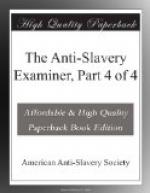Can language be more explicit or unequivocal? But have any donations been made by the United States for the support of colleges and schools in Ohio? Yes—by an act of Congress, the sixteenth section of land in each originally surveyed township in the State, was set apart as a donation for the express purpose of endowing and supporting common schools. And now, how have the scrupulous legislators of Ohio, who refuse to acknowledge any other than constitutional obligations to give ear to the cry of distress—how have they obeyed this injunction of the Constitution respecting the freedom of their schools? They enacted a law in 1831, declaring that, “when any appropriation shall be made by the directors of any school district, from the treasury thereof, for the payment of a teacher, the school in such district shall be open”—to whom? “to scholars, students, and teachers of every grade, without distinction or preference whatever,” as commanded by the Constitution? Oh no! “Shall be open to all the WHITE children residing therein!!” Such is the impotency of written constitutions, where a sense of moral obligation is wanting to enforce them.
We have now taken a review of the Ohio laws against free people of color. Some of them are of old, and others of recent date. The opinion entertained of all these laws, new and old, by the present legislators of Ohio, may be learned by a resolution adopted in January last, (1839) by both houses of the legislature. “RESOLVED, That in the opinion of this general assembly it is unwise, impolitic, and inexpedient to repeal any law now in force imposing disabilities upon black or mulatto persons, thus placing them upon an equality with the whites, so far as this legislature can do, and indirectly inviting the black population of other States to emigrate to this, to the manifest injury of the public interest.” The best comment on the spirit which dictated this resolve is an enactment by the same legislature, abrogating the supreme law which requires us to “Do unto others as we would they should do unto us,” and prohibiting every citizen of Ohio from harboring or concealing a fugitive slave, under the penalty of fine or imprisonment. General obedience to this vile statute is alone wanting to fill to the brim the cup of Ohio’s iniquity and degradation. She hath done what she could to oppress and crush the free negroes within her borders. She is now seeking to rechain the slave who has escaped from his fetters.
7. IMPEDIMENTS TO RELIGIOUS INSTRUCTION.
It is unnecessary to dwell here on the laws of the slave States prohibiting the free people of color from learning to read the Bible, and in many instances, from assembling at discretion to worship their Creator. These laws, we are assured, are indispensable to the perpetuity of that “peculiar institution,” which many masters in Israel are now teaching, enjoys the sanction of HIM who “will have all men to be saved, and to come to the knowledge of the truth,” and who has left to his disciples the injunction, “search the Scriptures.” We turn to the free States, in which no institution requires, that the light of the glorious gospel of Christ should be prevented from shining on any portion of the population, and inquire how far prejudice here supplies the place of southern statutes.




